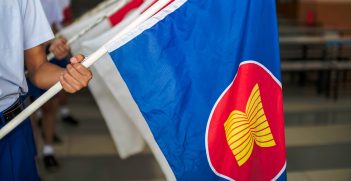Women-to-Women Diplomacy and Informal Peacebuilding in Post-Coup Myanmar

In Myanmar, women are fighting on two fronts: resisting the military regime and dismantling entrenched patriarchal norms. They use women-to-women diplomacy and informal peacebuilding efforts to mitigate conflict in a post-coup context, however, their contributions are often overlooked and undervalued.
In the ashes of a faltering national-level Nationwide Ceasefire Agreement process, a gendered analysis of women’s informal and unofficial peacebuilding efforts sheds light on the unique ways in which Myanmar women are mitigating conflict and sustaining peace in a post-coup context. Understanding women’s peacebuilding efforts in the context of a revolutionary conflict render mainstream peacebuilding approaches that focus on official diplomatic or “Track One” level peace negotiation processes insufficient in capturing and making visible these initiatives and practices.
On 1 February 2021, Myanmar’s military, known as the Tatmadaw, staged a coup d’état, overthrowing the democratically elected government led by the National League for Democracy (NLD). The military justified the coup by alleging widespread voter fraud in the November 2020 elections, which the NLD won by a landslide. Despite a lack of evidence supporting these claims, the Tatmadaw declared a state of emergency, effectively reversing a decade of gradual democratic reforms and plunging the country back into military rule.
In the aftermath, Myanmar has experienced widespread and severe violence, with the military conducting brutal crackdowns on pro-democracy protesters and armed resistance groups. Over 2,300 civilians have been killed, and more than 16,000 arrested, many of whom are subjected to torture and inhumane conditions. The conflict has displaced over a million people internally, with additional thousands fleeing to neighbouring countries. The humanitarian situation is dire, with the junta obstructing aid and targeting civilians through ground and air assaults. The international community has largely condemned the coup, but responses have varied, with calls for increased sanctions and global action to address the ongoing human rights abuses.
Led by a tech-savvy Generation Z, alongside passionate women activists, ethnic civil society leaders, and labour unionists, protesters swiftly embraced revolutionary goals. They demanded the abolition of the 2008 constitution and called for drafting a new one that would establish a true federal democracy and eliminate all forms of authoritarianism and discrimination against women and marginalised communities. In areas still under military control, resistance actors keep the spirit of defiance alive with spontaneous guerrilla-style protests and other creative acts of rebellion. Despite the regime’s attempts to stifle and block these efforts online, a vibrant community of artists, graphic designers, writers, poets, cartoonists, musicians, and filmmakers continue to voice their opposition to the coup. Despite the resilience, the military’s overwhelming firepower and readiness to commit atrocities continue to devastate communities, leaving a trail of destruction and fear.
In Myanmar, women are fighting on two fronts: resisting the military regime and dismantling entrenched patriarchal norms. Despite their critical roles in both armed and non-violent resistance, their contributions are often overlooked and undervalued. They face profound structural inequalities, exacerbated by the ongoing conflict, and are frequently targeted by the military through brutal tactics. Women are at the forefront of the pro-democracy movement, challenging both the junta and deep-seated gender norms. Despite their crucial roles as combatants, medics, activists, and organisers, women in Myanmar’s resistance often go underfunded, unrecognised, and excluded from decision-making. Since the military coup, the country’s humanitarian and political crisis has worsened, prompting responses from Ethnic Armed Organizations (EAOs), the People’s Défense Force (PDF), and other new actors. Amid this chaos, women-led civil society and community-based organisations are urgently forging multi-ethnic alliances and peacebuilding efforts.
Making visible informal peacebuilding spaces in Myanmar
Mac Ginty’s concept of “everyday peace” and United Nations Security Council Resolutions 1325 share several alignments, particularly in their emphasis on grassroots participation, inclusivity, and the importance of local agency in peacebuilding efforts. In Myanmar, women’s groups have been leveraging UNSC resolutions to push for empowerment and equality, aligning their efforts with global human rights standards. These resolutions are not just symbolic; they are powerful advocacy tools and a vital narrative for local activists striving for change. Integrating these principles within Myanmar’s peacebuilding context have been fraught with practical challenges. The goal of achieving 30 percent women’s participation in formal peace talks has not been met since 2015. This shortfall is due to entrenched gender norms, societal expectations of women as primary caregivers, the complexities of intersectional identities, and the perception of men as natural leaders. These obstacles are formidable but the determination of Myanmar’s women to break these barriers is unwavering.
Women’s roles in influencing ceasefire negotiations between 2011 and 2015, leading up to the Nationwide Ceasefire Agreement (NCA), are characterised by informal yet crucial contributions of women. Efforts by the Women’s League of Burma to hold the military accountable for violence against women have been largely unsuccessful due to a government focus on reconciliation over justice from 2015 to 2020. Women’s activism and informal dialogues significantly impact Myanmar’s peace processes and there remains a need to recognise these community-level contributions. While formal peace talks are essential, it is crucial to recognise the transformative role of women in peacebuilding, particularly in Myanmar, where social hierarchies are being challenged amid a larger revolution.
Women’s peacebuilding efforts in Myanmar: Beyond the formal process
Moving beyond formal peace spaces, one can see numerous examples of women’s peacebuilding in Myanmar. For instance, Kachin women in Myanmar have been actively reforming local practices and social dynamics, adopting diverse strategies to navigate the political landscape. They reject the one-dimensional notion of peace, and have instead embraced humanitarian, developmental, social, and political approaches. Their activism is rooted in shared experiences of suffering, leading them to file lawsuits against Myanmar military soldiers for sexual violence and form alliances with other women’s networks across ethnic lines. Against the backdrop of armed conflict in Kayah State in Myanmar, women utilise their care and silence as powerful tools for women’s peacebuilding, helping them keep their families and communities safe. The same practice has also been noted to perpetuate gendered insecurity and marginalisation for women amid the ongoing conflict.
The Women’s League of Burma (WLB)’s approach of women-to-women diplomacy has been significantly contributing to conflict transformation in Myanmar since the 1990s. Recognising peace as a process of social transformation, with cooperation consisting of grassroots dialogues among women, has had an ongoing and positive effect on such transformation. Women-to-women diplomacy naturally aligns with feminist arguments for women’s inclusion as peace agents, stressing that gender justice is inseparable from sustainable peace. In a similar vein, women’s civil society organisations (WCSOs) bridge social divides and promote grassroots peace in Myanmar through fostering social interaction among women, sharing experiences of conflict struggles, and striving for gender equality. Such efforts take various forms including grassroots leadership training, seminars, and conferences as well as the formation of alliances like Women’s League of Burma (WLB) that transcend religious and political boundaries.
Understanding the nexus between gender, civil society, and informal peace spaces in post-coup Myanmar shows that in the context of a fraught and frozen national-level process, a gendered analysis of women’s informal and unofficial peacebuilding efforts makes visible the unique ways in which Myanmar women are mitigating conflict and sustaining peace in a post-coup context. Theoretical peacebuilding approaches that focus on official Track One processes are not sufficient in capturing and making visible these initiatives and practices–but they are there and making absolutely critical contributions to Myanmar society–both towards and beyond the bounds of formal negotiations.
This op-ed is based on the forthcoming article, “Rebuilding Prospects for Peace: Gender, Civil Society, and Informal Peace Spaces in Post-Coup Myanmar” as part of a Special Issue funded by the Canadian International Development Research Centre.
Dr Julia Palmiano Federer is a Senior Researcher at the Center for Security Studies at ETH Zürich. She is also currently a Senior Fellow at the Negotiation and Conflict Resolution Collaboratory at the Harvard Kennedy School’s Center for Public Leadership.
Aye Myat Su Wai is a Master of Public Policy candidate at the Australian National University (ANU). Her background as a refugee on the Thailand-Myanmar border led her to focus her research on peace and conflict studies, human rights, freedom of expression and activism in Myanmar.
This article is published under a Creative Commons License and may be republished with attribution.





